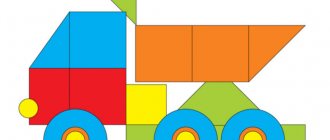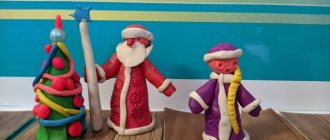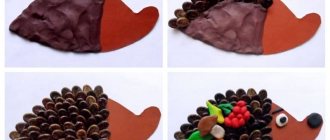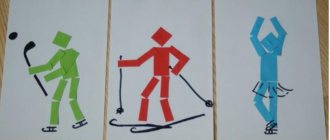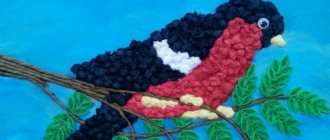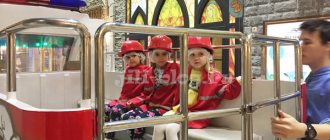Application of a man in motion
The next level of complexity is considered to be the appliqué of a person in motion. This application for children will seem more painstaking and will require their concentration.
But, in addition to basic skills, it will allow children to study the structure of the body, the names of poses and directions of movements. The basis of this technique is the application of a person from geometric shapes.
This time you will need to make more smaller pieces:
- The arms and legs are depicted from two thin rectangles;
- The human torso is a square or rectangle;
- The head is a smaller square or circle;
For clarity, you can always offer the child a basis from which he can start and continue to act independently: for example, glue torso figures for two people at once onto a piece of paper, and invite the child to glue his hands so that the figures are in different poses.
Of course, all the names of the poses need to be voiced and shown to the baby by example. As experience accumulates, the child will be able to create compositions from several figures depicting active ball games, physical education lessons, swimming, dancing and many other movements familiar to him.
Application of a person's face made of paper
Having seriously studied body parts and geometric shapes, you can distract yourself a little and do more creative things - applique of the human face.
Here the child gets more space for imagination and enjoys studying not only the parts of the face and their names, but also practices using facial expressions to distinguish and show different emotions.
As with other applique techniques, parents need to talk about the face, sensory organs and their functions, show them to the baby on the body and discuss their position relative to each other.
On a sheet of paper, you should mark the outline of the face with a pencil, or prepare a circle or oval from paper, which will become the basis of the face and the rest of the elements will be placed on it.
You should try to prepare several variations of facial elements in advance:
- Different eye colors and sizes;
- Eyebrows of different shapes
- Several nose options;
- Several smiles expressing different emotions;
- Ears of different sizes and shapes;
- Hair: hairstyles for boys and girls;
- Additional accessories (bow, hat, etc.).
In the process of making the applique, it is better to help the child stick the base face onto a sheet of paper and place the eyes correctly on the face - they will become a reference point for the baby, relative to which all other elements of the face need to be positioned.
By gluing eyebrows above the eyes, a nose in the center of the face, ears parallel to the eyes, the child learns the basics of symmetry and proportions. Several stencil options will add an element of play and fun to this process.
A beautiful applique will not only delight your baby, but will also immerse him deeper into the world of creativity.
Studying human anatomy using application
Older children can also use appliques to learn body anatomy. The older the child, the more elements of internal organs will be needed. To begin with, it is enough to use blanks to illustrate the brain, lungs, heart, stomach, liver and kidneys.
The more organs the child knows, the more new elements can be added, for example, adding intestines, spleen, etc. to the application.
Since studying anatomy is a lengthy process, appliqué elements are usually made of durable multi-colored materials, such as felt or colored cardboard.
Organ templates can be taken from human anatomy atlases.
Applications for advanced
All creative tasks develop imagination in children and adults, a craving for handicrafts and art. When we learn to make appliqués with our own hands, then, as with any task, we can approach the matter precisely and strictly “as per the manual,” or we can add elements of play and even mischief.
To further involve your child in the process, use other, non-standard materials in addition to paper:
- Thick knitting threads that can be woven into braids are well suited for hair;
- For hairstyles and beards - cotton wool;
- To depict clothes, you can mix different materials: paper and fabric, glitter, paper curls;
If you have mastered paper applique, you can safely move on to other types: appliques made from beads, from seeds, from autumn natural materials.
The main thing is that children and adults enjoy this process.
